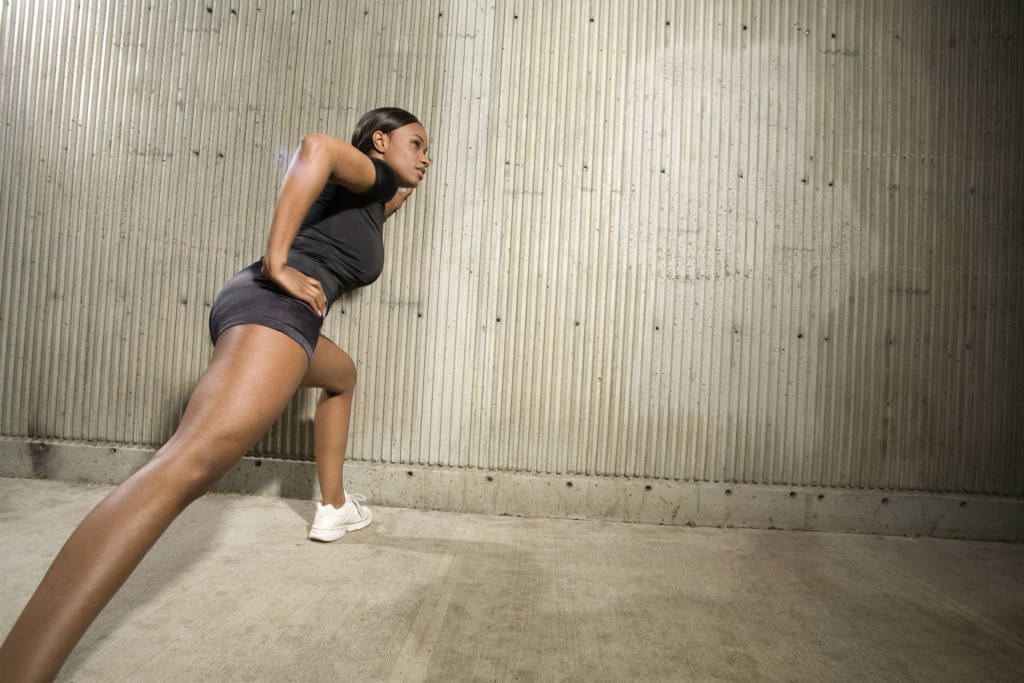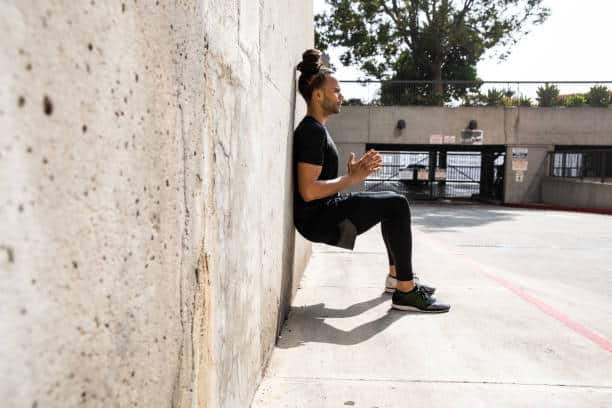 You may not always feel like going to the gym or running/walking, but trust and believe there are NO days off when getting (and keeping) your glutes, legs, and thighs toned! If you’re in minimalist mode, try this simple three-exercise circuit. All you need for this workout is a flat, bare wall and about three feet of clear floor space (a mat is optional).
You may not always feel like going to the gym or running/walking, but trust and believe there are NO days off when getting (and keeping) your glutes, legs, and thighs toned! If you’re in minimalist mode, try this simple three-exercise circuit. All you need for this workout is a flat, bare wall and about three feet of clear floor space (a mat is optional).
If you want to keep it tight, keep it right. Do three sets of each exercise, resting one minute in between each set (if you absolutely must). The exercises can be done with shoes on or off to avoid messing up your walls.
1. Wall Squats
You can probably feel the burn in your quads (muscles on the front of your thighs) just reading the phrase “wall squats”! This exercise is great for not only building strength and endurance in your quads, but also the glutes and calves.
- Start by standing with your back pressed against a wall, with your feet shoulder-width apart about two feet from the wall.
- Slowly slide your back down the wall until you’re in a squatting position, with your thighs parallel to the floor.
- Adjust your feet so that your legs make a 90-degree angle, with your knees aligned directly above your ankles. If your knees are over your toes, slide up a little.
- Keep your back flat while holding the position.
READ: 5 Simple Exercises For Lower Body Toning Wall Workout
2. Marching Bridges
Bridges are a great way to give some focused attention to your glutes and the hamstrings (back of the upper leg). Doing them correctly is also a great core-strengthening exercise. Marching bridges take this move up to the next level!
- Lie down on your back, arms at your side, and knees bent up with your toes touching the wall.
- Tighten your abs (squeeze your core and try to pull your belly button toward your spine) and slowly walk your feet up the wall,
lifting only your hips off the floor. - March your legs in toward your chest (keep one foot on the wall at all times). Engage your glute and ab muscles to keep your hips high.

3. Foot-Up Split Lunge
There’s the lunge and then there’s the foot-up lunge! Guess which one will work you harder? Picking up your foot will add plenty of thigh-toning intensity and will target the muscles in your legs and core.
- Stand with your back against the wall and take one large step forward.
- Lift your back leg and place your toes against the wall. Square your hips to the front and lean your body forward slightly.
- Slowly bend your front knee to 90 degrees, with your knee aligned over your ankle, and press back up to straight.
- Switch legs and repeat.
RELATED: 6 Best Workouts for Sore Joints
Wall Workout: What Are the Benefits?
Wall workouts offer a surprising range of benefits, utilizing a simple and accessible tool – a wall – to enhance various aspects of fitness. Here’s a breakdown of the key advantages:
Strength Training:
- Increased Resistance: The wall can provide a stable surface to push against, increasing the intensity of bodyweight exercises like wall sits, wall push-ups, and planks. This added resistance helps build muscular strength and endurance.
- Isometric Holds: Many wall exercises involve isometric contractions, where muscles are engaged without movement. Wall sits, for example, powerfully engage the quadriceps, hamstrings, and glutes through sustained tension. Research suggests isometric exercises can be particularly effective for building strength and may even lower blood pressure more than other types of exercise.
- Full Body Engagement: Exercises like wall walks engage multiple muscle groups, including the shoulders, triceps, core, chest, and legs, providing a comprehensive workout.
- Accessibility: Wall workouts require minimal or no equipment, making them convenient for home workouts or when you don’t have access to a gym.
Flexibility and Mobility:
- Deeper Stretches: The wall provides support and stability, allowing for deeper and more controlled stretches for various muscle groups, including hamstrings, calves, hip flexors, shoulders, and back.
- Improved Range of Motion: Regular wall stretches can help increase flexibility and improve joint mobility.
- Enhanced Spinal Articulation: Exercises like wall roll-downs promote spinal flexibility and stretch the back muscles.
Posture Improvement:
- Spinal Alignment: The wall acts as a guide to help you understand and maintain proper spinal alignment during exercises.
- Muscle Engagement for Posture: Wall exercises engage core muscles and back muscles that are crucial for good posture. For example, wall sits help strengthen the core muscles that support the spine.
- Counteracting Slouching: Exercises like wall angels specifically target opening the chest and shoulders, counteracting the effects of hunching and poor posture.
- Increased Body Awareness: Using the wall can enhance body awareness, helping you recognize and correct postural imbalances.
Balance and Stability:
- Improved Coordination: Isometric exercises performed against a wall can improve communication between your muscles and brain, leading to better physical coordination and balance.
- Enhanced Stability: The wall provides a stable base, allowing you to focus on engaging stabilizing muscles during exercises.
Other Benefits:
- Low Impact: Many wall exercises are low-impact, making them suitable for individuals with joint pain or injuries.
- Injury Prevention: Strengthening and increasing flexibility through wall workouts can contribute to preventing injuries.
- Rehabilitation: Wall exercises can be a safe and effective way to rehabilitate after certain injuries.
- Weight Management: While not primarily cardio, the muscle-building aspect of wall workouts can help boost metabolism and burn more calories over time.
Accessibility for All Levels: Wall exercises can be modified to suit various fitness levels, from beginners to advanced individuals.

Wall Workout Tips
Wall workouts are a fantastic way to enhance your fitness using a simple and accessible tool. Here are some essential tips to maximize the effectiveness and safety of your wall workouts:
Preparation and Safety:
- Stable Wall: Ensure you’re using a sturdy, non-slip wall. Avoid walls with loose paint or wallpaper that might peel off.
- Clear Space: Make sure the area around the wall is clear of any obstacles to prevent trips or falls.
- Proper Footwear: Wear appropriate athletic shoes with good grip to avoid slipping, especially during exercises like wall sits or calf raises.
- Listen to Your Body: Pay attention to any pain or discomfort. Modify exercises or stop if you feel any sharp or persistent pain.
- Warm-up: Always start with a dynamic warm-up to prepare your muscles for exercise. This could include arm circles, leg swings, and torso twists.
- Cool-down: Finish your workout with static stretches, holding each stretch for 20-30 seconds. Focus on the muscles you worked.
Visit the BlackDoctor.org Fitness center for more helpful articles and tips.








